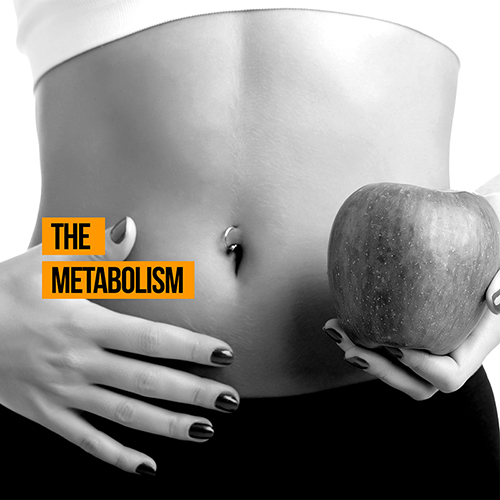From the inception of the sports supplement market, many health industry market leaders have produced products designed to boost the metabolism. But what actually is the famed metabolism, how does it work and how can one keep it ‘burning’ naturally? Toby Cryne investigates.
“The metabolism is a complex thing indeed. Regularly used within the semantic fields of weight loss, muscle gain and even endurance training, the term metabolism isn’t an actual thing per se.
Rather, it is a set of occurrences. A complex umbrella term which that is flaunted about across the health and fitness industry in a variety of forms, the metabolism is defined by the Oxford Dictionary as: The chemical processes that occur within a living organism in order to maintain life.
Put simply, there is no such thing as the metabolism; the metabolism is merely a collective term for a number of processes which are far more complex than one could note on these pages. Nevertheless, one can break down the term metabolism in to two rough processes in order to simplify it; catabolism and anabolism.
Catabolism is the breakdown of nutrients such a food such as carbohydrate, fat and proteins into simple forms which can then be used for energy. This can also apply to the processes by which the body utilises stored energy to fuel it such as during weight loss or starvation. Anabolism is the process by which nutrients such as proteins are extracted from foods to repair damaged tissues. When excess nutrients are consumed, anabolism can be used to describe the process of fat storage in the body.
But an adequately working metabolism is essential for more than just weight loss and gain. In fact, a properly functioning metabolism is required to keep you alive due to the body’s reliance on the nutrients you consume on a daily basis. Without the proper extraction of energy from these nutrients, your body wouldn’t function properly at all.
Metabolism Myths Debunked
Now that we know what the metabolism is, let’s take a look at some of the top misconceptions about the metabolism and how it works in the fields of health and fitness.
- In contrast to popular belief, skinnier people do not have faster metabolisms. On the contrary they actually have a slower resting metabolism as there is physically less of them to burn. A lower body mass therefore will equate to a slower metabolism. Typically larger folk will have higher resting metabolisms due to their larger body mass, this allows them to burn more calories at rest. This is especially true of those with a more muscular frame as muscle burns more calories at rest than fat. As a result, a muscular person will have a higher resting metabolism than a person with a higher fat percentage and will consequently use more calories in a day than someone of equivalent weight but higher body fat and lower muscle mass levels. As such, resistance training is just as important as weight loss specific training in a typical fat loss workout regime.
- Eating later in the day or at night has often been touted as a reason for extra fat storage when the reality is that this popular myth is completely untrue. Science seems to suggest that the most important factor in terms of weight loss or gain is the net calories consumed over a set period of time. Dr Yoni Freedoff from the University of Toronto Medical School notes that: “the time of day you fill your car with gas isn’t going to impact how far you’ll go on that tank”. The same theme can be applied to weight loss or gain with the reality being that the amount of weight you lose or gain is directly influenced by the amount of calories you consume over a given time frame. This is one of the reasons why elite bodybuilders will wake during the middle of the night in order to consume a greater amount of net calories.
- The frequency of meals debate is also one that is hotly disputed in the bodybuilding and fitness world. The old adage of “eat little and often to keep the metabolism burning” is actually based on little scientific fact at all. Though certain foods such as chili or ginger may have a thermogenic effect in that they cause a rise in core temperature, science shows that meal frequency doesn’t actually matter. A 2010 study by the University of Ontario concluded that no significant difference in weight loss occurred in groups who consumed three larger meals versus those who consumed the same calorific density over six meals. The study concluded that: “increasing meal frequency does not promote greater body weight loss under the conditions described in the present study.”
Natural Metabolism Boosters
The rate at which your metabolism works can be determined by a number of factors such as; age, gender, body composition and activity levels. But more than ever science is now pointing to the power of certain foods to help increase the chemical processes and assist in the absorption of nutrients. This is due to a number of processes such as thermogenesis and thethermic effect of food which occur when digestion takes place in the body.
Thermogenesis is a term for the increase in core temperature in the body which, in turn, increases the metabolic rate. The thermic effect of food is the effect that any consumed item has on the digestive system. Put simply, the body needs to use calories in order to digest those consumed. Certain foods create higher demands on the digestive system, which in turn causes the body to burn more calories during their digestion. The following foods are examples of thermogenic consumables or thermic effect causing ones. Stock up your fridge and pantry with the following to keep you firing on all cylinders!

- Green Tea: Having been used for centuries in China, Green Tea has now become one of the most popular beverages in the West. The tea contains a host of antioxidants which have been shown to help metabolism function, increase thermogenesis and, unlike coffee, keep your breath fresh!
- Chilli: The Chilli Pepper is one of the most health full food items that you can have in the pantry. Containing a number of heart healthy compounds and chemicals known as capsinoids, the Chilli Pepper can help to raise body temperature (thermogenesis) which in turn can help you burn more calories in a day. A study by the American Chemical Society in 2010 found that the chemical capsaicin in the pepper shrunk fat cells and helped eliminate fat deposits from the blood.
- Protein: Proteins found in animal and plant sources are exceptionally difficult for the body to digest. Requiring up to 20-30% of the body’s energy during digestion, the consumption of proteins such as meats, fish and soy will create a thermic effect on the digestive system and burn a greater amount of calories during digestion than fat or carbohydrate calories.
- Iron: Iron helps to transport oxygen to and assist in the production of red blood cells, a lack of which will slow down the metabolic rate, cause anaemia and create fatigue. Those on low calorie or meat-free diets are particularly susceptible to such conditions. Iron can be found in a host of foods such as oysters, mussels, pumpkin seeds, lentils and broccoli.
- Caffeine: A 1980 study by the American Journal of Clinical Nutrition found that metabolic rate increased significantly over three hours after caffeine consumption in both control and obese individuals. Caffeinated beverages such as coffee or tea assist by increasing the demands of the central nervous system which in turn increases metabolic rate. Adding a cup of Joe or regular morning Espresso will stoke your metabolism into action for up to three hours afterwards. Just stay clear of the syrups.
Have you any top tips for boosting the metabolism? Get in touch using the below social media links and let us know what you think!”


